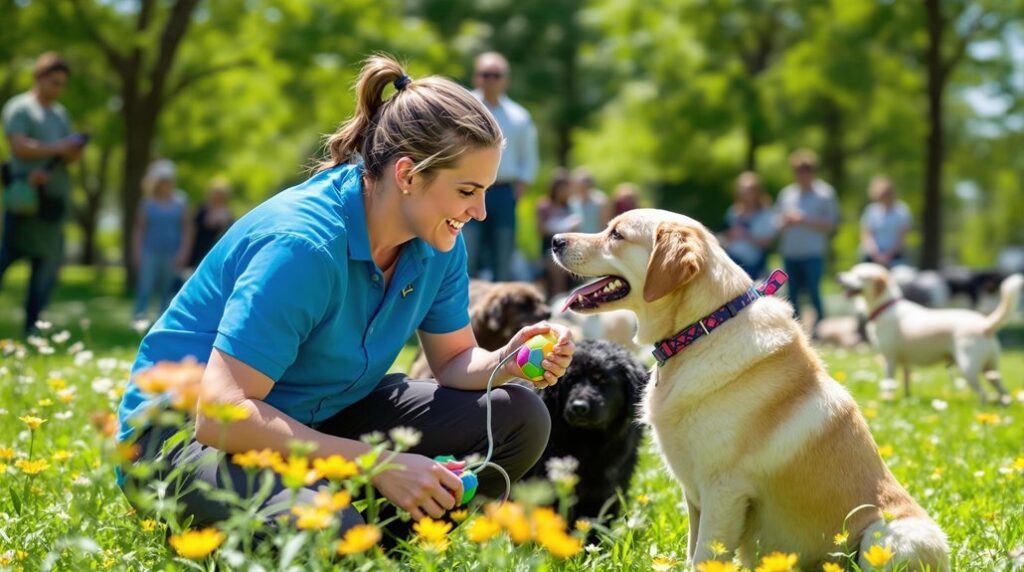Local pet training services are fundamental for building a strong bond between you and your pet. They offer various programs, such as obedience training, puppy classes, and behavior modification, each targeting specific skills and issues. Utilizing positive reinforcement techniques, these services foster trust and reduce stress in pets. It's important to choose a trainer with proven experience and recognized certifications to suit your needs. Understanding their methods is significant for your pet's success, so there's much more to uncover.
Understanding the Importance of Pet Training
When you consider bringing a pet into your home, understanding the importance of training is essential, as it not only fosters a harmonious relationship between you and your pet but also enhances their quality of life. Training provides your pet with essential skills, allowing them to adapt to your household environment effectively. It reduces behavioral issues, such as excessive barking or chewing, which can lead to frustration for both you and your pet. Furthermore, a well-trained pet is safer; they can respond to commands in potentially dangerous situations, preventing accidents. Additionally, training strengthens the bond between you and your pet, promoting trust and communication. Ultimately, investing time and effort into training guarantees a more enjoyable and fulfilling life for both you and your furry companion.
Types of Local Pet Training Services
Numerous types of local pet training services cater to various needs and preferences, ensuring that every pet owner can find an appropriate option. These services often specialize in different aspects of training, allowing you to choose what fits your pet's requirements best. Here are some common types of training services available:
- Obedience Training: Focuses on basic commands and social behavior.
- Puppy Classes: Designed for young dogs to learn essential skills.
- Agility Training: Enhances physical coordination and mental stimulation.
- Behavior Modification: Addresses specific behavioral issues, like aggression or anxiety.
- Private Lessons: One-on-one sessions tailored to your pet's unique needs.
Benefits of Positive Reinforcement Techniques
Positive reinforcement techniques have become increasingly popular in pet training due to their effectiveness and humane approach. By rewarding desired behaviors with treats, praise, or playtime, you encourage your pet to repeat those actions. This method fosters a positive bond between you and your pet, enhancing trust and communication. Research shows that animals trained through positive reinforcement exhibit lower stress levels, making them more receptive to learning. Additionally, these techniques can lead to faster training results, as pets are motivated to engage in behaviors that yield rewards. Ultimately, using positive reinforcement not only helps you achieve training goals but also contributes to your pet's overall well-being, creating a harmonious and enjoyable environment for both of you.
How to Choose the Right Trainer for Your Pet
How can you guarantee that you find the right trainer for your pet? Selecting a qualified trainer is essential for achieving effective training results. Here are some key factors to take into account:
- Experience: Look for trainers with proven experience and positive reviews.
- Training Methods: Confirm their methods align with your pet's needs and your values.
- Certifications: Check for recognized certifications in pet training.
- Specialization: Reflect on trainers who specialize in your pet's breed or specific issues.
- Trial Sessions: Ask if they offer trial sessions to assess compatibility.
Common Behavioral Issues Addressed in Training
While many pets exhibit unique personalities, certain behavioral issues are commonly addressed in training sessions. These issues often create challenges for both pets and their owners, necessitating professional intervention. Understanding these behaviors can help you identify what needs to be addressed during training.
| Behavioral Issue | Description |
|---|---|
| Excessive Barking | Dogs may bark due to boredom or anxiety. |
| Jumping on People | This behavior often stems from excitement or lack of training. |
| Separation Anxiety | Pets may become distressed when left alone, leading to destructive behavior. |
| Aggression Towards Others | This can arise from fear, territorial instincts, or lack of socialization. |
Addressing these issues can lead to a more harmonious relationship between you and your pet.
Expectations for Pet Training Sessions
Setting realistic expectations for pet training sessions is essential for both owners and their pets. Understanding what to anticipate can enhance the training experience and lead to better results. Here are some key points to reflect upon:
- Training takes time; progress is often gradual.
- Consistency is vital; practice regularly for lasting effects.
- Every pet learns at their own pace; don't rush the process.
- Positive reinforcement is key; reward desired behaviors for better outcomes.
- Communication with your trainer can clarify goals and address concerns.
Building a Lasting Bond Through Training
Training your pet isn't just about teaching commands or correcting behaviors; it's a critical opportunity to build a strong, lasting bond between you and your animal. Engaging in training sessions fosters communication, as you learn to understand each other's signals and cues. This connection enhances trust, making your pet more responsive to your guidance. Additionally, consistent training reinforces positive behaviors, leading to a harmonious living environment. As you work together, you'll celebrate small victories, further solidifying your relationship. It's important to remain patient and consistent, as these qualities contribute to mutual respect. Ultimately, a well-trained pet not only exhibits good behavior but also thrives on the bond established through training, ensuring a fulfilling partnership for years to come.
